Small Brown Beetles (In the House and Outside) – With Pictures and Identification
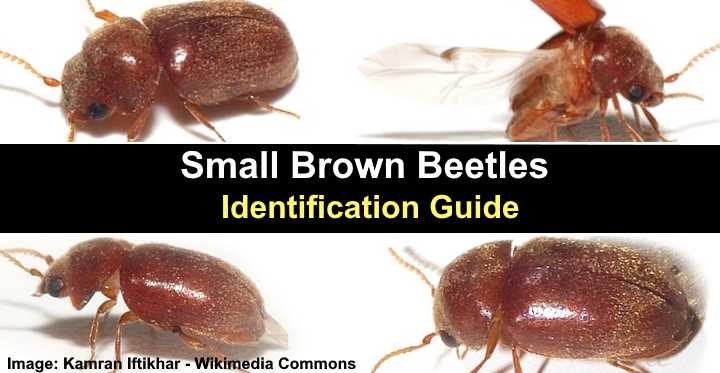
Small brown beetles can become pests in the home or outside in your yard. Some types of small brown indoor beetles are commonly found in pantries, crawling in dried cereals, boring in furniture, or infesting carpets.
Common small brown beetles that can be found in the house are biscuit beetles and larder beetles, These little brown beetles are often found in kitchens where food is stored.
Brown beetles are also common in gardens, where you might discover June beetles, brown click beetles, or European chafers damaging your plants or lawn.
Tiny brown beetles can be challenging to identify because of their size. Some of the smallest brown beetles in the house can be as little as 0.082” to 0.15” (2 – 4 mm) long. On the other hand, brown beetles you find outdoors in your yard tend to be larger and can measure around 0.78” (20 mm) long.
This article is a guide to help identify small brown beetles in the house and outside. Descriptions and pictures of these tiny brown “bugs” will help you know the type of beetle you have found.
Small Brown Beetle Facts
Common brown beetles are insects with six legs, two antennae, and an oval body. There are thousands of beetle species, all in the insect order Coleoptera. Most adult beetles have two sets of wings protected by two wing covers. Although not all brown beetles are considered pests, many tiny brown beetles can become a nuisance indoors.
Small Brown Beetle Identification
Small brown beetles are identified by their body shape, behavior, and habitat. Observe if the brown beetle has an oval or elongated rounded body to help determine the species. In addition, you may notice that some beetles have a large, rounded head, whereas others have a small head and club-like antennae.
Another way to determine the species of brown beetle is by looking at the antennae. There are different antennae shapes, some with serrated, segmented, or club-like antennae.
Does the brown bug you spotted in your house have a long, unusual snout? In that case, the brown beetle is a type of weevil. Brown weevils are also beetles and are identified by their elongated body and long protruding snout they use to consume food.
Small Brown Beetles in the House
Opening a packet of flour or cereal to find tiny brown bugs can send you into a panic. However, you could notice brown beetles anywhere in the home. They can infest bedrooms, bathrooms, or living rooms. In addition, you may find them in carpets, soft upholstered furniture, drug cabinets, or baking mixes.
Are you wondering: “What is that brown insect in my house?” If so, please read on to identify the species of brown beetle you’ve discovered.
Biscuit Beetle (Stegobium paniceum)
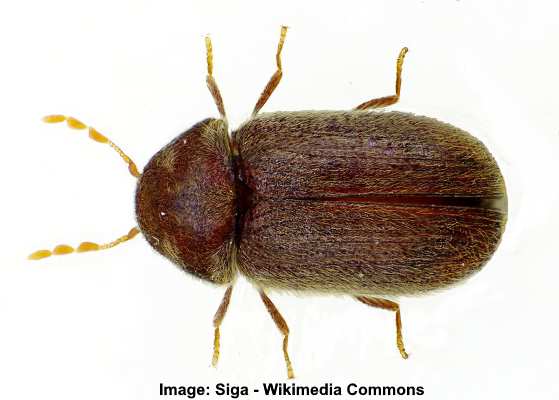
The biscuit beetle is a tiny brown beetle with a hard shell that is commonly found in packets of dried food products
The biscuit beetle is one of the most common small brown beetles you will find in the house. The tiny brown biscuit beetle has a cylindrical body and brown, reddish color. These tiny brown insects measure 0.86” to 0.13” (2.5 to 3.5 mm) long. Its identifiable antennae have a three-segmented club end.
Biscuit beetles also go by the name drugstore beetles, biscuit weevils, and bread weevils. The common names of Stegobium paniceum refer to its habitat. You’ll often find the tiny brown biscuit beetle in flour, dry mixes, cookie jars, spices, and the drug cabinet. In addition, the beetles can feed on wool, leather, and hair.
Biscuit beetles are hard to tell apart from cigarette beetles. Apart from being tiny insects, the brown beetles have a similarly shaped body. However, biscuit beetles don’t have serrated antennae or smooth wing coverings like the cigarette beetle. Instead, their wing covers have a pitted appearance and segmented antennae.
Thankfully, preventing biscuit beetles from invading your foodstuffs is relatively straightforward. First, always check food packaging when bringing groceries home. Then, store grains, flour, and other dry food items in air-tight containers. Finally, if you notice that foods are infested, wrap them in heavy plastic and dispose of them in the outdoor trash.
It’s always a good idea to clean up any spilled products and keep under refrigerators, tables, and pantries clean from crumbs and other bits of dried food.
Small Brown Beetle Identification: Biscuit beetles are identified by their rounded, cylindrical body, reddish-brown color, and two antennae with three segments at the ends.
Varied Carpet Beetle (Anthrenus verbasci)
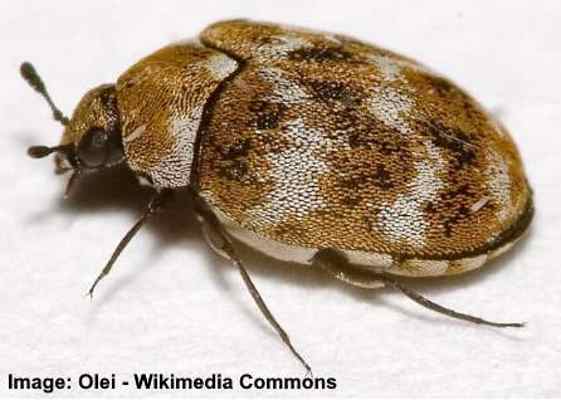
The tiny varied carpet beetle feeds on natural fibers and has brown, white and yellow-beige body
The varied carpet beetle is a type of brown beetle with a mottled brown, white, and yellowish body. The beetle’s body is like a rounded shield and is large in contrast to its small head and stumpy black antennae. The varied carpet beetle ranges in size from 0.07” to 0.14” (1.7 to 3.5 mm).
Varied carpet beetles get their name because they feed on natural fibers. Infestations of brown carpet beetles in the house can cause damage to carpets, clothing, and furniture. However, the larvae, not the adults, usually do the most damage to soft furnishings.
Varied carpet beetle larvae are identified as tiny furry brown caterpillars measuring 0.2” (5 mm) long.
Small Brown Beetle Identification: Varied carpet beetles have a recognizable brownish mottled body, round, almost spherical shape, segmented antennae, and six spindly legs.
Larder Beetle (Dermestes lardarius)
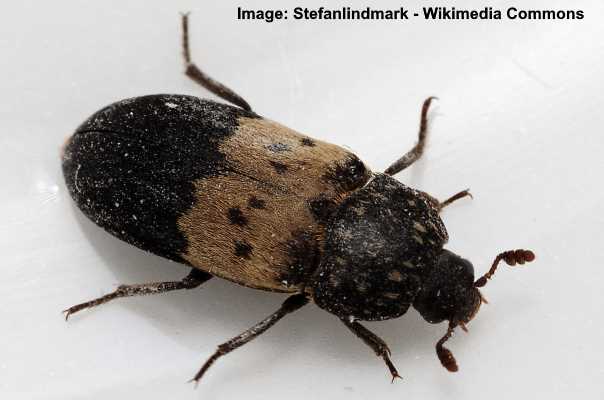
The small brown and black larder beetle feeds on dried foodstuff
The larder beetle is a black and brown beetle with an elongated, oval body, six legs, and two club antennae with segmented ends. The adult larder beetle measures 0.33” to 0.38” (83 – 95 mm). The easily identifiable larder beetle has a brownish band and six black dots on its back.
The larder beetle gets its name because it’s often found near foodstuffs. The small black and brown larder beetle feeds on dried meats, cheese, grains, and pet food. You may also find that the beetle larvae bore holes in wood and drywall.
The best way to control larder beetles is by keeping all dried food products in sealed containers. Also, don’t leave pet food out overnight and keep trash cans securely sealed. These annoying beetles are also called moisture bugs. Therefore, fixing leaking plumbing can help to prevent attracting the beetles.
Small Brown Beetle Identification: Larder beetles have an identifiable brown to tan band on their back with three black spots on each side. The black and brown beetle has club antennae and a black head.
Red Flour Beetle (Tribolium castaneum)
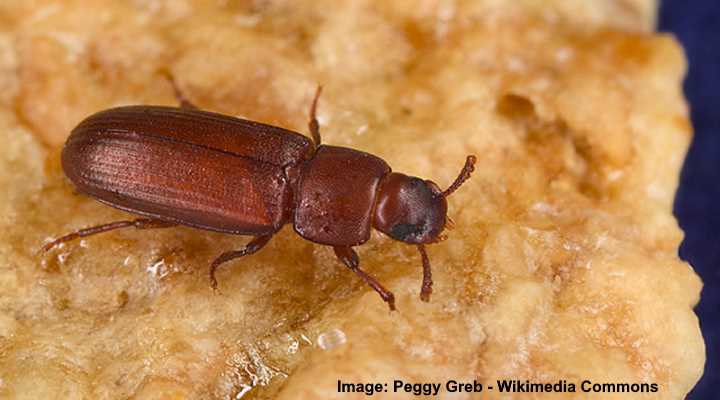
The red flour beetle has a reddish-brown elongated body and can be found near dried food products
The red flour beetle is another type of beetle that can invade homes and live in foodstuffs. These small beetles have a brown or rusty-brown body. The beetles have a recognizable oval abdomen and measure around 0.13” (3.1 mm) long. They can also use their wings to fly short distances.
You can tell if you have red flour beetles in your home if you see the tiny beetles flying or crawling around. Also, you may notice holes in cereal boxes or discover the reddish-brown beetles in flour and other cereal products. Like other brown beetles in the home, keep dry food products in air-tight containers to avoid attracting them.
Small Brown Beetle Identification: Red flour beetles have a shiny reddish-brown oval body and two identifiable antennae with a three-segmented club end.
Furniture Beetle (Anobium punctatum)

The furniture beetles are small dark brown beetles and their larvae cause damage to timber and to household furniture
The furniture beetle is a blackish-brown beetle with an elongated oval body and six legs. They measure 0.11” to 0.18” (2.7 – 4.5 mm) long. Pictures of the brown beetles show they have a dark body with ridges and dimples and segmented antennae. However, adult furniture beetles don’t cause damage.
The damage that furniture beetles cause in the home is due to their larvae. As their name implies, furniture beetle larvae bore into timber, creating woodworm holes in wood. Typically, high air humidity and damp wood create the ideal environment for furniture beetles and their larvae to thrive.
Small Brown Beetle Identification: Furniture beetles have a dark brown body described as an ellipsoidal shape. The tiny beetles have a recognizable prothorax that looks like a monk’s cap or cowl.
Cigarette Beetle (Lasioderma serricorne)
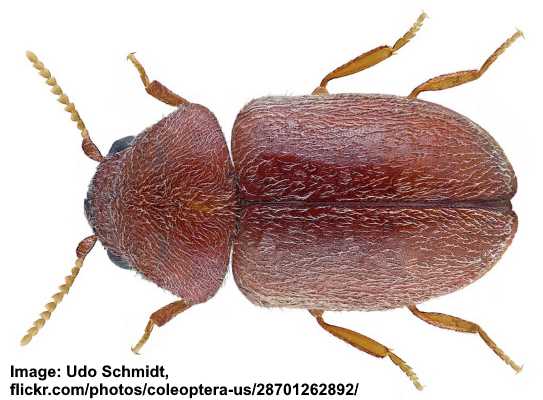
The tiny brown cigarette beetle is attracted to dried tobacco products and dry foodstuff
A cigarette beetle is a type of shiny brown beetle with a rounded, oval body covered in fine hairs. The small brown beetles measure 0.78” to 0.11” (2 – 3 mm) and often lurk in dark crevices. These annoying beetles can be found in stored dry food products.
Cigarette beetles get their name because they are attracted to dried tobacco products. The oval brown beetles look like drugstore beetles. However, these tiny brown pests have serrated antennae, not the club-like antennae of drugstore beetles. Also, cigarette beetles have a smooth, not ridged body.
Small Brown Beetle Identification: Drugstore beetles are identified by their brown, oval bodies and habit of hiding their head and legs and staying motionless when disturbed.
American Spider Beetle (Mezium americanum)

The American spider beetle is a little brown beetle that looks like a small spider
The American spider beetle is a reddish-brown insect with rigid wing coverings, tan-colored slender legs, and segmented antennae. The tiny brown beetle measures 0.06” to 0.13” (1.5 – 3.3 mm). A characteristic trait of brown spider beetles is their rounded abdomens, giving them a spider- or mite-like appearance.
Brown American spider beetles can become a pantry pest as they feed on stored foodstuffs in your kitchen. The annoying bugs can be found in seeds, spices, cereals, dried fruits, beans, and bread. They are also attracted to tobacco and cayenne pepper.
Like other pests that can infest your larder, the best way to deal with American spider beetles is to prevent them from getting into your packets of dried foodstuffs.
Small Brown Beetle Identification: American spider beetles have a bulbous dark brown body with a glossy sheen, six long light-brown legs, and a tan-colored head.
Types of Small Brown Beetles
Small brown beetles can also be found in yards and gardens where they may feed on ornamental plants, or their larvae can damage roots.
June Beetles
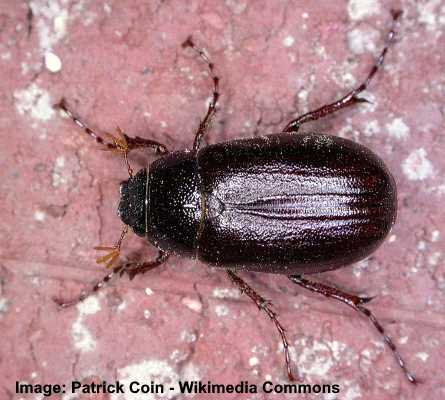
Some June beetles in Phyllophaga genus have a shiny dark brown or reddish-brown body
There are over 900 species of June beetles in the genus Phyllophaga, some of which have a reddish-brown color. Also called June bugs, the brown beetles measure 0.47” to 1.38” (12 to 35 mm) long. The beetles have a shiny body, spiny legs, and short antennae. Adult June beetles are also called chafers.
Brown June beetles are found munching through deciduous leaves in the summer. You may notice them on broadleaf trees, ornamental shrubs, and flowering plants. The beetle larvae are also a type of white grub that destroys plants, legumes, and turfgrass at the roots.
Other types of June beetles in the genus Cotinis can have dull brown bodies with green stripes. However, there is a significant variation in the genus, with some beetles having spectacular metallic green bodies.
Small Brown Beetle Identification: Brown June beetles have a shiny reddish-brown body, six legs covered in jaggy-looking spines, and short antennae.
Rice Weevil (Sitophilus oryzae)
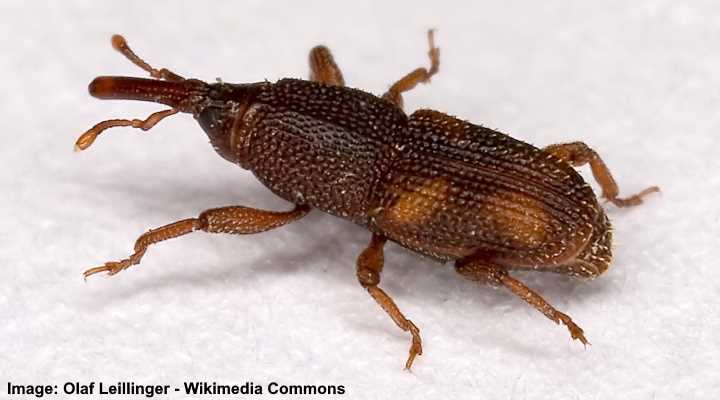
The rice weevil is a type of small brown beetle identified by its elongated snout
The rice weevil is a rusty-brown colored insect with an elongated oval body and characteristic brown snout. In addition, the dark, orangey-brown body has recognizable spots on its wing covers. The unusual beetle measures 0.11” to 0.17” (3 – 4.5 mm) long. The destructive pests look like maize weevils.
Rice weevils are described as one of the most serious grain pests globally. The brown bugs attack stored grains and cereals, and they can fly to new locations. The nasty brown insects also lay eggs in dried food products, where they pupate and develop into brown weevils.
Small Brown Beetle Identification: Rice weevils have identifiable yellow or reddish spots on their hard protective wing covers. The prothorax has a recognizable pitted appearance, and the head has a long snout.
Click Beetles (Elateridae)
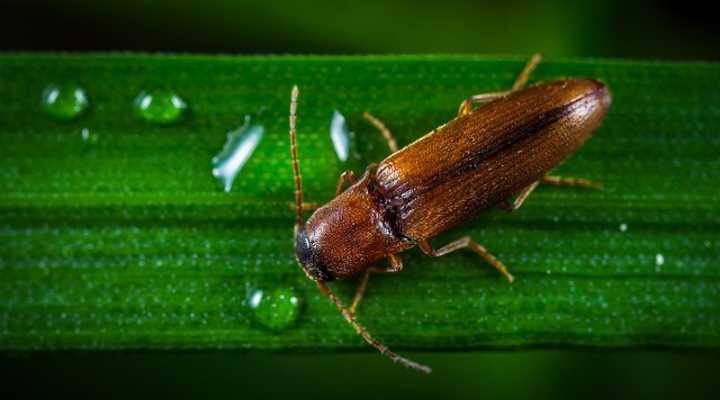
Denticollis linearis (in the picture) is a type of a small brown beetle belonging to the family Elateridae
Click beetles are a group of beetles that make a characteristic clicking or snapping noise. Many species of click beetles are black or brown and measure less than 0.78 (20 mm) long. Click beetles have an elongated brown body with a fused head. The shiny brown body has a black band running down its center.
Adult click beetles are nocturnal, and you will rarely see them during the daytime. Although there is color variation among the many species of Elateroidea, most have serrated antennae, markings on their heads and back, and can “click” themselves into the air.
Small Brown Beetle Identification: Click beetles are identified by their slender, elongated shiny brown body, black markings on wing covers, and making an audible clicking sound.
Asiatic Garden Beetle (Maladera castanea)
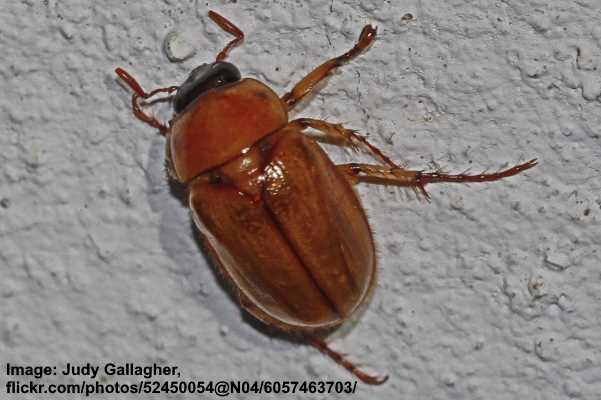
The little brown Asiatic garden beetle causes damage to garden plants
The Asiatic garden beetle is a winged insect with a cinnamon-brown body that looks like a tiny coffee bean. These brown flying beetles measure 0.37” (9 mm) and become a nuisance when attracted to lights. The pesky flying beetles get into homes at night through poorly-sealed doors and windows.
The brown beetles are more of a nuisance pest indoors than destructive. However, the plant-destroying bugs can cause damage in your yard when feeding on geranium, rose, chrysanthemum, and aster leaves and flowers. In addition, the white grubs that live in the soil can cause brown patches on lawns to appear.
Related reading: How to kill Japanese beetles in the garden.
Small Brown Beetle Identification: Asiatic garden beetles are recognizable brown flying bugs with cylindrical bodies, spiky antennae, and six spiny legs.
European Chafer (Amphimallon majale)

The light brown European chafers are active in late spring and summer
The European chafer is a small-sized beetle with a light reddish-brown oval body, light brown spiny legs and prothorax. Looking at close-up pictures of this brown beetle, you’ll see that there are light-yellow tufts of hair on its body. The brown beetles are 0.5” to 0.55” (13 – 14 mm) long.
European chafers are identifiable in the summer as swarms of flying brown beetles that are active in late spring and summer. You will find them on shrubs and low trees. You may also notice the carcasses of dead brown chafers under the trees.
The damage in your garden caused by European chafers is due to their larvae activity, not the adults. The large white C-shaped grubs hatch in the ground and gorge on the roots of trees, shrubs, and lawn grass. The white grubs cause patches of turfgrass to turn brown. In addition, wildlife foraging for the larvae do even more damage to lawns by digging them up.
Small Brown Beetle Identification: European chafers are identified by their oval brown body and grooves along their wing covers. It has legs covered in jaggy spines and two lamellate antennae.
Synchroa Bark Beetle (Synchroa punctata)

The Synchroa bark beetle has dark brown or black elongated body and can cause damage to trees
The synchroa bark beetle is a slender-looking beetle with a dark brown or black body. The elongated, bullet-shaped, flattened dark brown beetle has thin lines down its wing covers. Also, the beetle has long antennae. Brown synchroa bark beetles measure 0.27” to 0.51” (7 – 13 mm) long.
Bark beetles usually do damage to weakened trees and can eventually kill them. The brown bark beetles feed and breed under the tree’s bark, and they can cut off nutrients and water to twigs and branches. Signs of synchroa bark beetles are small holes and tube lines on the trunk or limbs.
Small Brown Beetle Identification: The synchroa bark beetle has a long, slender, dark brown, oval body.
Discover other types of house beetles.
Related articles:
